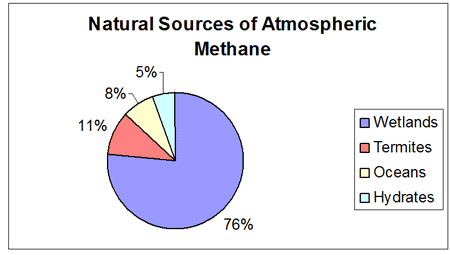MethaneMethane (CH4) is a greenhouse gas contributing to about 18% of global warming and has been on the rise over the last several decades. Though methane makes up far less of the atmosphere (.0002%) than carbon dioxide, it is 20 times more potent than CO2 as a greenhouse gas. Methane is a product of the decomposition of organic matter, with major natural sources being that which occurs from wetlands, termites, the oceans, and hydrates.
Figure 3.4 Natural Sources of Methane A major source of methane is from termites. Termites eat wood and produce methane as a result of the breakdown of cellulose in their digestive tracts. They are thought to be responsible for 11% of the methane in the atmosphere (some estimates are as high as 20% - 40%). The clearing of the rain forests greatly impacts termite populations and in turn the methane content of the atmosphere. When a patch of rain forest is cleared, termite populations explode due to the ample food source that is left behind.
Human activities have contributed to the rise of methane in our atmosphere. Landfills, rice paddy agriculture, natural gas systems, and livestock production appear to be significant contributors of anthropogenic sources of methane. OzoneOzone (O3) is both beneficial and
harmful to life on Earth. Much of the ozone in the atmosphere is found in
the
stratosphere
Human-produced compounds such as chlorofluorocarbons and halides containing chlorine and bromine destroy ozone, and have disrupted the fragile stratospheric ozone layer over Antarctica and the Arctic. Ozone depletion over Antarctica occurs during the spring when sunlight returns to the South Pole and the temperatures are still very cold. Video: Exploring Ozone |

This work is licensed under a Creative Commons Attribution-ShareAlike 4.0 International License..

